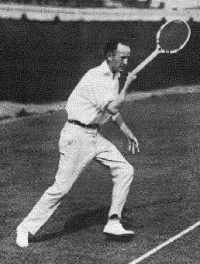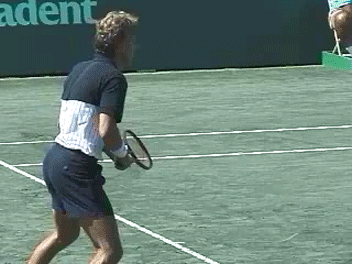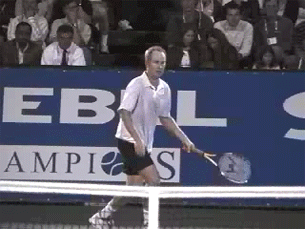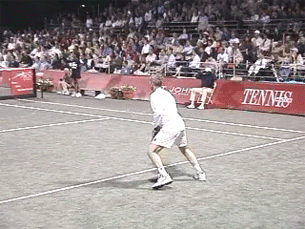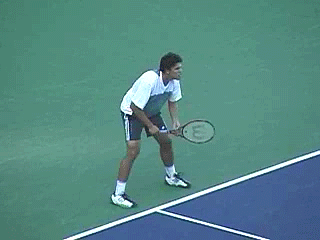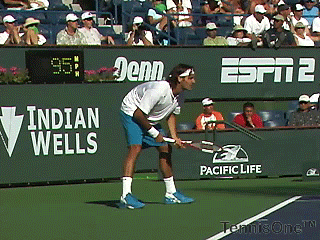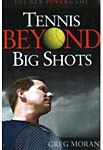| TennisOne Lessons The Forgotten Forehand Greg Moran Years ago, before tennis became a game dominated by extreme grips and supersonic forehands, most of the major tournaments were held on grass courts. The ball didn’t bounce very high or straight as it came off of the lawn, so players did all they could to hit their shots in the air. They often used one grip (usually the continental) for all of their strokes and serve and volley specialists ruled the game.
During this era, an effective weapon in a player’s repertoire was the slice forehand. The widely used continental grip was ideal for hitting with slice plus, the spin kept the ball even lower as it came off of the grass surface. Players such as Rod Laver, Billie Jean King, Margaret Court and Ilie Nastase would cleverly use the slice forehand to torture their opponents. Then, in the early 70’s, the ultra cool Bjorn Borg sauntered onto the scene. He brought with him a Western grip, a heavy topspin forehand, and a pied piper charisma. His style of play was unique for the times yet some doubted it’s potential. Paul Fein writes in his brilliant book Tennis Confidential that, “skeptics derided his Western game as unsuitable for grass, on which three of the four Grand Slam events were still contested. He would prove them wrong soon enough by amazingly winning five straight Wimbledon titles from 1976 to 1980.”
Add to that six French Open titles and Borg secured his legendary status and, in many circles was credited with “inventing topspin.” Fein corrected that misconception in his book by pointing out that “sixty years before Bjorn Borg parlayed his Western forehand into six French Open and five Wimbledon titles, “Little Bill” Johnston whacked Western forehands, which he developed on slick, high-bouncing California cement and asphalt courts, and won the 1915 and 1919 U.S. Open Championships and the 1932 Wimbledon.” Fein goes on to quote “Big Bill” Tilden as saying that “His (Johnston’s) forehand drive will always be renowned as one of the greatest shots the game has ever known.” Nevertheless, Borg’s success spawned a new type of player. As the 70’s turned into the 80s, the topspin forehand became a staple of the modern game and rightfully so. More and more tournaments were being contested on hard surfaces, where the ball bounced up high and players could take a good rip at it. Two of the three Grand Slams followed suit and abandoned their grass courts. The U.S. Open (after temporarily switching to clay in 1975) switched to DecoTurf (a hard surface) in 1978 when it moved to its present home in Flushing, New York and the Australian Open moved to a hard surface called Rebound Ace in 1988.
Plus, as racquet technology evolved, players were holding more potent weapons in their hands and the power era exploded. 100 mph forehands were in and the slice became one of the game’s black sheep shots. Because slice moved slower though the air than balls struck with topspin, and had a tendency to rise, slice forehands were viewed as sitting ducks and largely forgotten by players and teaching pros. Though topspin is King in today’s game, the fact is, the slice forehand can still be a potent weapon in your arsenal. Let’s first take a look at how to hit it and then I’ll offer some scenarios under which you can use it. How to Hit the Slice Forehand
One reason the slice forehand is often overlooked is that so many players today are using semi-western and western grips. These grips naturally close the racquet face (strings pointing towards the court) and would require an awkward bending of the wrist to open it for slice. That being said, the Eastern or Continental grips are best for executing the slice forehand. As you see the ball approaching, immediately turn your shoulders and begin your backswing. Move the racquet back so that it is approximately even with your right shoulder. You don’t need a large backswing when hitting slice because you’re not going to take a big swing at the ball. As I said, slice rises (as opposed to topspin which falls) so if you take a huge swing, your shot will likely sail out of the court. Your racquet head should be above your wrist, slightly open (pointing towards the sky) and approximately six inches above the oncoming ball. You can adjust higher or lower according to the height of the oncoming ball. Keep your wrist firm and elbow tucked in towards your body. A good visual is to imagine your racquet and arm forming roughly a 90 degree angle, similar to your preparation for a volley. As you approach the ball, shorten your steps to fine-tune your positioning. When the time comes to swing, take a large step forward with your lead foot. Try to make contact 1-2 feet in front of your body with your racquet traveling in a downward motion to impart the slice. The amount of slice you place on the ball can be adjusted by the severity of your downward motion. To hit with less slice, swing your racquet with more of a forward motion. To place more slice on your shot, swing with more of a downward path. Like all shots hit with spin, there are various degrees. Trial and error will enable you to develop the necessary “feel” to use the spin effectively. After contact, your racquet should slightly move upward. This ascension becomes particularly important the deeper you are in the court as it will prevent you from driving the ball down into the net. The early part of your follow through will take the racquet head below your waist or even your knees, but the pendulum effect will carry it back up to roughly shoulder height. As with all of your shots, remember to keep your head still and eyes focused on the point of contact for a split second after the ball leaves your strings. Your head is the heaviest part of your body and even a slight movement can through your stroke off. Once you begin to get the feel of the slice forehand, here are six situations where it can be useful:
Though topspin may be your spin of choice the majority of the time, if you can add the slice forehand to your game, you’ll be a much more versatile and winning player! Your comments are welcome. Let us know what you think about Greg Moran's article by emailing us here at TennisOne.
Tennis Beyond Big Shots presents a bold back-to-the-future approach. A new game that moves away from power and big shots yet is more lethal to opponents than any booming serve. Greg Moran shows players of all ages and abilities that, with simple and small changes, you can not only maximize your tennis wins and play longer, but also have much more fun doing it. Click link to purchase Greg Moran's book, Tennis Beyond Big Shots. Mansion Grove House is pleased to announce that in May, 2008, they will release the second edition of Tennis Beyond Big Shots. Written by Greg Moran, the book (which includes a new chapter) was Amazon's #1 new tennis release in 2007. |
|||||||||||||||
